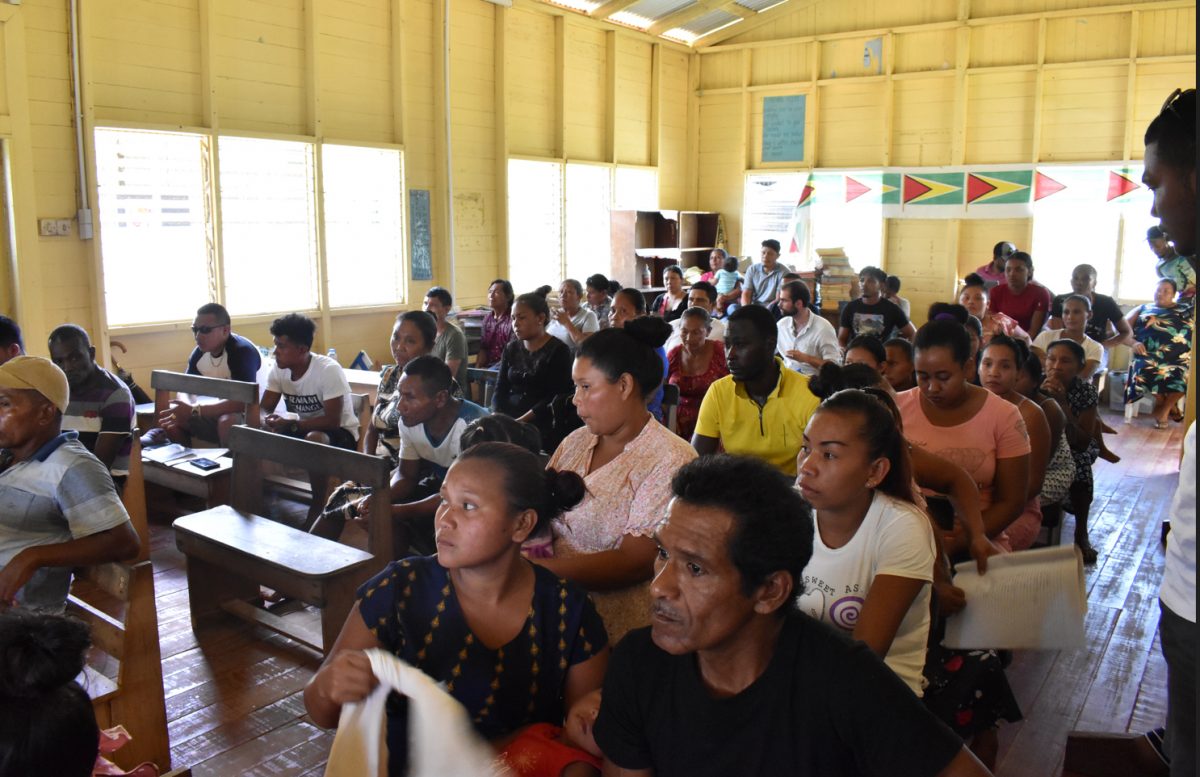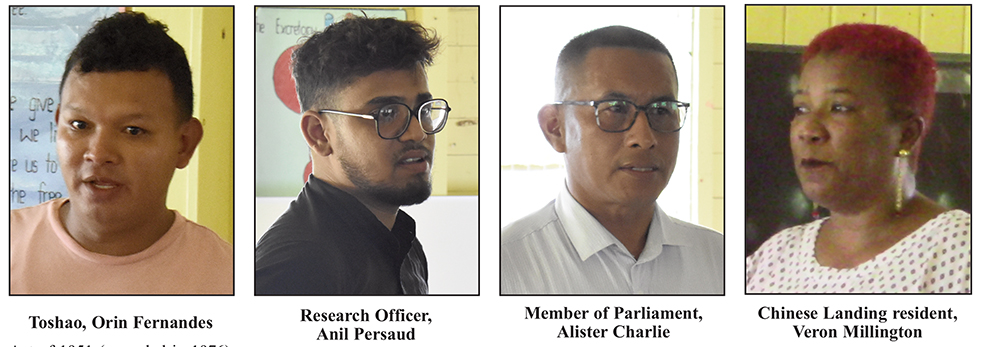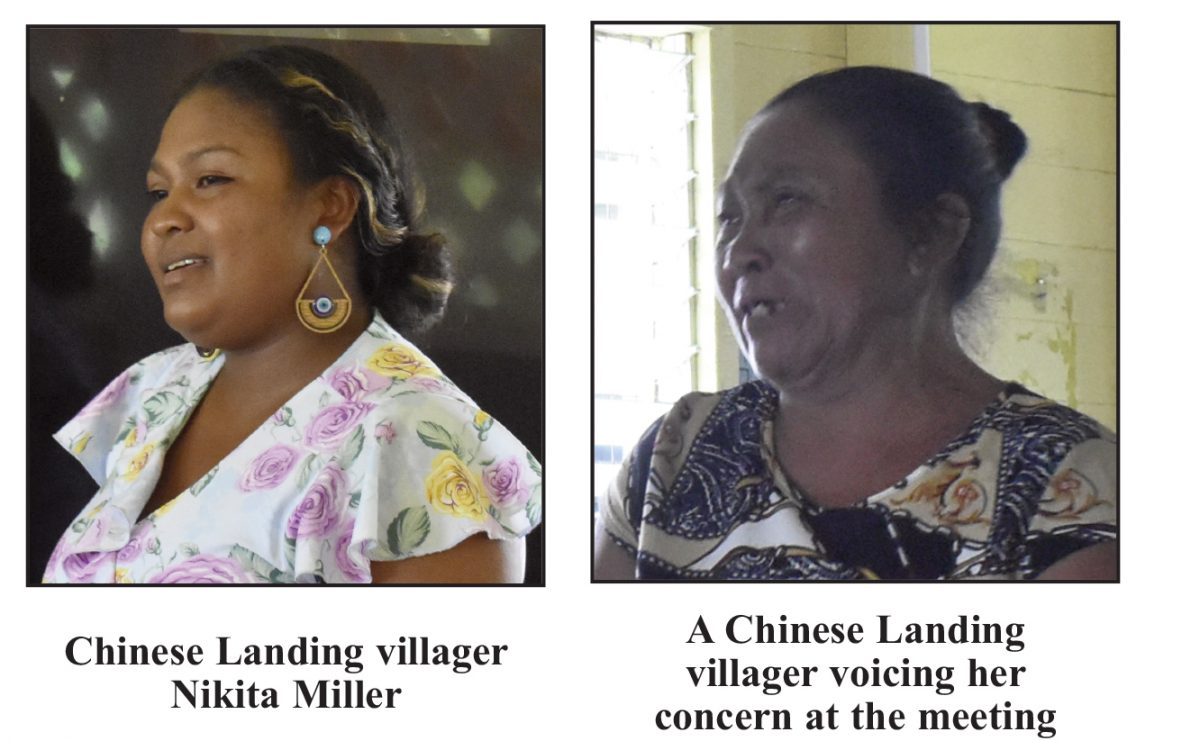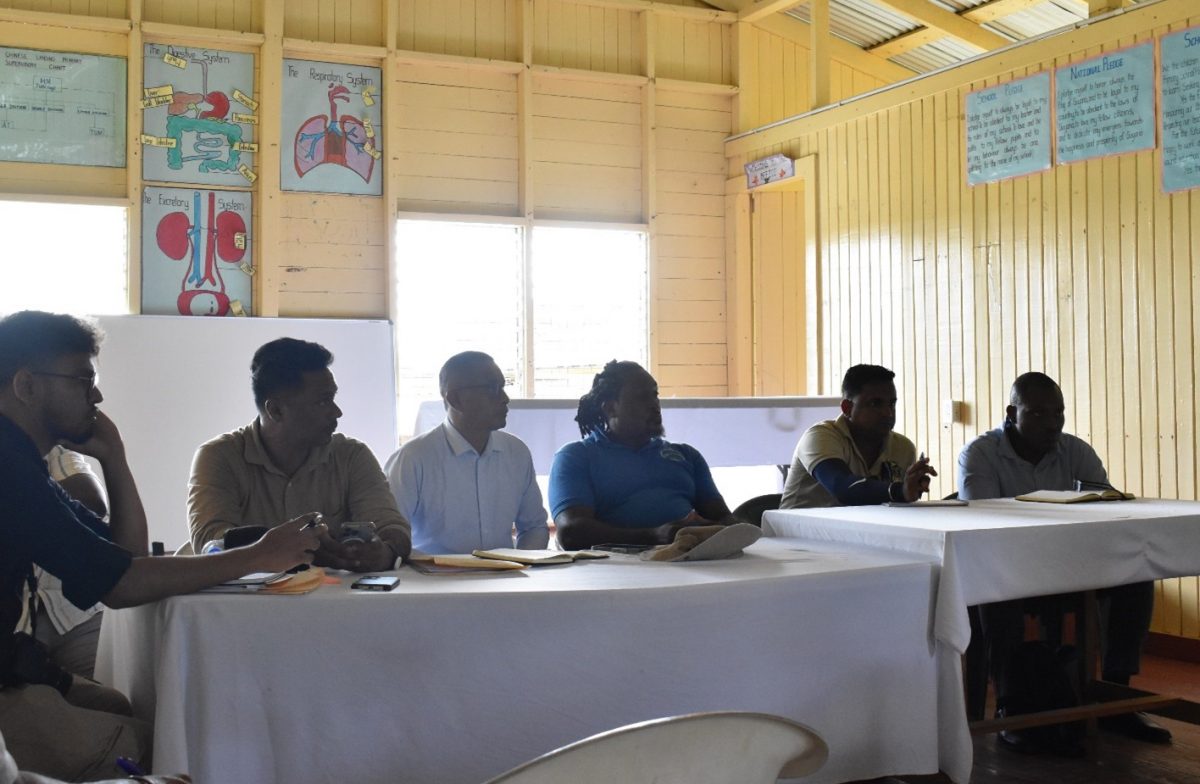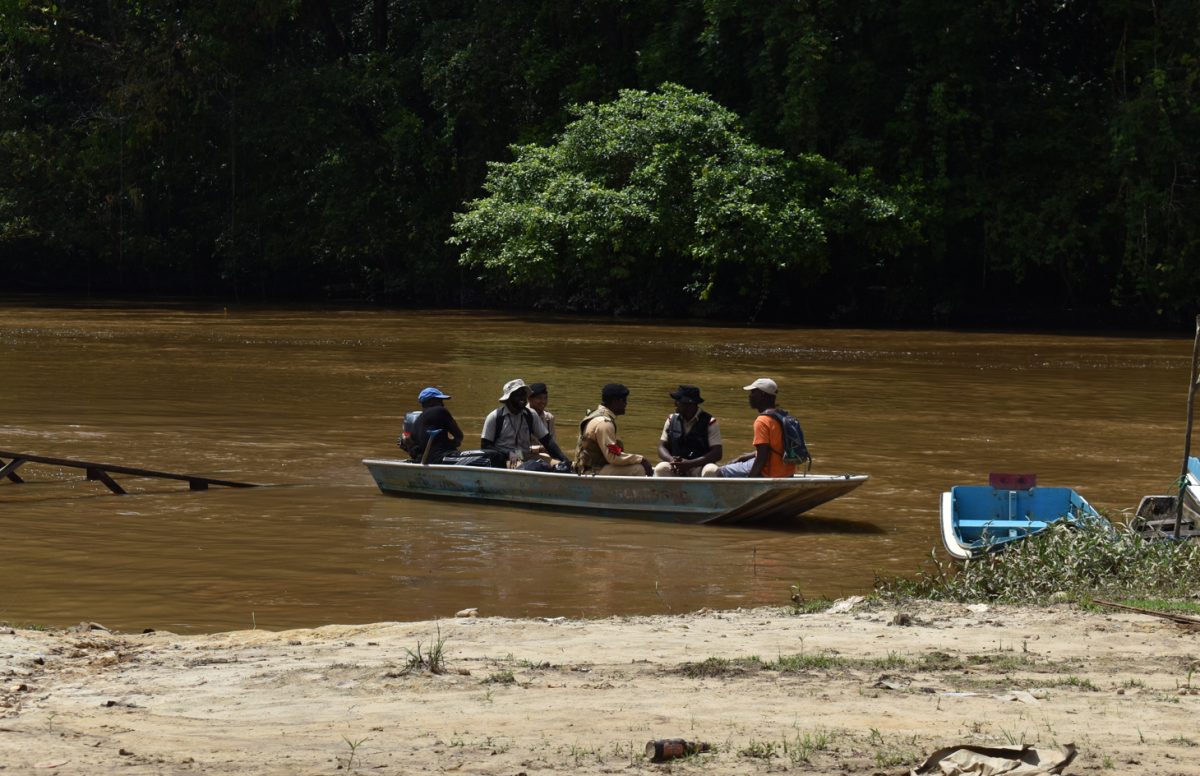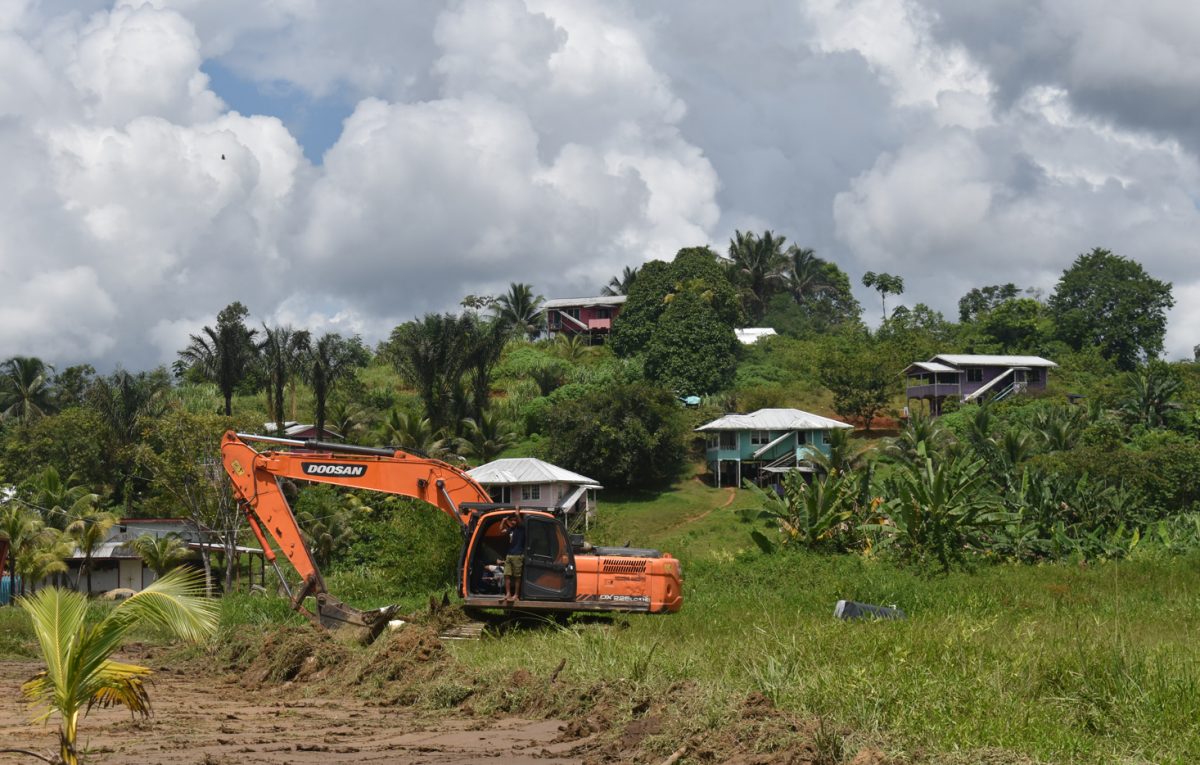By Joseph Allen
During a fact-finding mission mounted by the government, residents of Chinese Landing in the north west were adamant that miner Wayne Vieira must be removed from their lands.
They cited the numerous efforts over the years in and out of the courts to settle the matter to no avail.
The fact-finding meeting followed a request on July 21 from the Inter-American Commission on Human Rights (IACHR) for the Government of Guyana to take the following steps (A) the state must take the necessary measure to protect the rights of life and personal integrity of the members of the indigenous Carib community of Chinese Landing to prevent threats, harassment and other acts of violence against the community members; (B) the state must consult and agree upon the measures to be adopted with the community and other representatives, and (C) report on the actions taken to investigate the events that led to the adoption of these precautionary measures, so as to prevent such events from reoccurring.
The government was asked by the IACHR to respond within 20 days and that period has now elapsed.
The fact-finding team for the August 7 meeting consisted of Member of Parliament, Alister Charlie; Anil Persaud, Research Officer of the Ministry of Parliamentary Affairs and Governance (MOPAG); Officers from the Guyana Geology and Mines (GGMC); the Environmental Protection Agency (EPA); Ministry of Health, and the Office of Professional Responsibility of the Guyana Police Force. Notably absent was any representative from the Ministry of Amerindian Affairs. The governmental team informed the residents of Chinese Landing that they are a “fact-finding” team. This meeting, according to Persaud, was concerned only with aspect (C) of the recommendation from the IACHR. On the other hand, Charlie said that based on what he heard, the team will conduct their investigation and everything that is said will be acted upon.
Angered by the fact that, after years of complaints, the Government had now chosen to send a fact-finding mission, the residents demanded a complete cessation of all mining activities, citing what they called the daily violations of their human rights.
“Today, I thought that the team is coming to give us some positive answers, rather than that, we got to keep repeating ourselves over and over. So, as per the (IACHR ruling), I thought we were going to hear some positive answers to see how we are going to deal with Mr. Wayne Vieira, since for the past years we have been going through this struggle,” Nikita Miller, a Council Member of the Community said. Miller said the current conversation ought to be the removal of Vieira from the land.
“To come to this day, today again, I think our main proposal is to get Wayne Vieira off the land and if you can’t do it; then send someone who can do it because we want our land and we are asking you, if the blocks can be revoked. I think it’s in the Government’s hand and they can revoke it”, she asserted.
Miller, who said that she has been on the council for 12 years in various capacities, questioned why the matter has not been resolved instead of the talks that are continuing.
“This is really hard for our Amerindian People, this should have never happened. Do you think we could go to your (officials’ place) and take your lands? Never. We will never do that. Look at the dress that I have on, I don’t have money to buy clothes… sometimes I go all day without eating. Where are we going to get the money from and they are taking away our lands?” a tearful Miller asked.
In their filing with the IACHR, residents along with their Village Council, complained about their rights and livelihood being violated by Vieira’s Mining Company. These violations stemmed from threats to the environment and threats to the residents.
Proximity
There are four mining blocks assigned to Vieira, all of which run through the community. With the mines and mining activity being in close proximity to residences, lands for hunting and farming, villagers, of necessity, have to navigate through them to access spaces to conduct their daily activities. Residents say they are often hindered by threats and violence allegedly from security guards of the gold businesses.
A resident, Veron Millington, questioned the Government’s decision to even sell the land that is already too small to accommodate the people. “My villagers are not very happy because let me explain to you. When we got the land title in 1976 they were 74 people living on Chinese Landing, in which Chinese Landing may be the smallest Amerindian Village. You are saying that whether we are with the Government or not, it’s their duty to help our Amerindian people. You tell me something… how much, you pick sense out of nonsense here. We have a little piece of land to accommodate 74 people for a period of time. Out of that, this said loving Government will sell four medium scales (concessions) straight across our village.
To get from this field to this field; we have to cross there to get over there. The mining blocks are the main land, anything beyond that is a swamp”, she said.
Further, Millington said that this has affected the entire village economy, leaving them with nothing. “They’re taking mining from all these little children; from my grandparents go right down this is what they use to do, battel mining when they are not hunting and fishing which you know is seasonal. When there is nothing left to do, we hunt, we fish and when it’s out of season, we spin battel to get money.
Now, all of this the Government take this and give this miner that has money and there is nothing left”, she lamented.
The resident then suggested that since the village is without the help of the Government, it will move to the court for help. Village Toshao, Orin Fernandes, pointed out that this has happened because they have been fighting for years without the help of Government to win back their lands and it’s quite disappointing that they did not get that help and so the village had to seek outside help.
“After almost five-plus years, here we are again, and the matter has not yet concluded. We reach far out of Guyana and the matter here has not been resolved as yet. To be honest with you, as a leader, I never intend(ed) to go so far because if we were getting the help that was supposed to be given to us, here, there was no need to go further”, he stated. Fernandes added that the only thing on the minds of the villagers, as they explained, is for the miners to be removed with all their equipment. He said that he remains glad that mining has being halted for now pending the investigation but the call remains for their entire removal. MP Charlie, in his remarks, sought to assure the community that despite all that was said, the Government stands with the people of Chinese Landing. “The Government stands with the people of Chinese Landing and we will be forwarding a report, complying this report and you will see the fruits of it,” Charlie promised.
History
Chinese Landing is an indigenous Carib Community located on the Barama River with a population of 210 villagers whose population is predominantly female. The community’s main source of income is from gold mining and livelihoods are sustained through traditional food gathering activities such as hunting, fishing, and farming. Chinese Landing obtained its land title under the Amerindian Act of 1951 (amended in 1976). Further, the title was reissued in 1991 under State Lands Act (1991) under state lands and in 2018, the village received its Certificate of Title pursuant to the Land Registry Act.
On March 8th, the IACHR received a request for precautionary measures filed by the Village Council of the Indigenous Carib Community of Chinese Landing, the Amerindian Peoples Association of Guyana and the Forest People’s Programme (on behalf of the members of the Indigenous Carib Community of Chinese Landing). The request called on the Government of Guyana to adopt the necessary steps to protect the health, rights, personal integrity, and life of the people. This request came as the people of Chinese Landing were contending that Vieira, a concession beneficiary, was given four blocks to mine for gold, but along with his associates, continued to daily harass and threaten villagers.
It was noted that villagers were not able mine anymore as the blocks, owned by Vieira, cut through the entire village and when villagers try to mine in the area left, they are met with aggression from Vieira’s security. The Toshao also alleged that he was attacked by the company’s representatives, and at times, the villagers are harassed by miners. These aggressions, the residents claimed, continue on a regular basis even as residents try to pass through or near the mines to go about their business of either farming or other daily activities. At times, the villagers noted that guns would be fired off indiscriminately.
The residents also argued that the waters which they use are contaminated by mercury. The contamination has left some villagers sick and with skin rashes. Furthermore, the residents contend that Vieira continues to use heavy-duty machinery for his mining activities which has resulted in large scale degradation to the land and increased deforestation. The residents complained that while these matters were reported, a team was sent to conduct an investigation but no in-depth investigation was done in the medical issue. Residents also allege that officers of the GGMC and the security forces continue to shield Vieira and the reported wrongdoings.
Based on the above report, the Government was asked by the IACHR for a response to such claims. In a response to the IACHR, the state first questioned whether the village was being represented by an organization rather than the rightful council. The Government noted that the Council does not have the authority, under the Amerindian Act, to give such powers to an organization. The state explained that Vieira entered a ten-year agreement on July 1998, which gave it a portion of the land for medium scale mining and in 2004, the Ministry of Amerindian Affairs wrote GGMC, stating that the people of Chinese Landing no longer desired to renew that permit. GGMC nevertheless went ahead and issued Vieira a mining permit. In 2007 the Ministry again raised the issue with GGMC, noting that the GGMC act was a breach of faith as the 2006 Amerindian Act made provision for the consent of the village before the permitting of medium scale mining.
In 2010, GGMC issued a cease work order to Vieira who, in 2011, in court, challenged the legitimacy of GGMC to issue a cease work order. The High Court squashed the decision on the ground that GGMC has no authority to issue such order under section 48 of the 2006 Amerindian Act. GGMC appealed the decision and in 2016, the Appeal Court overturned the High Court’s decision, leading to the Caribbean Court of Justice (CCJ) overturning the Appeal Court’s decision on the basis that the cease work order, by the mines officer for the purpose of enforcing a requirement under the Amerindian Act, is unlawful particularly under the Amerindian Act, given that the Amerindian Act had its own procedures for enforcement which can only be administrated by a different authority.
In 2021, Chinese Landing filed a claim against GGMC and Vieira. The court ruled that Vieira did not need permission to enter the claims which were covered by mining permits. The court ruled that materials vested within the lands held and occupied in Chinese Landing are vested by the state. This decision was appealed and is now up for adjudication by the appeal court. In response to claims of threats, the state explained that they deployed Joint Services patrols in the area and no such illegal activity was recorded. In June 2022, the state noted that a meeting was held with the Council, residents of various villages including Chinese Landing, and the issue of security was raised. The State insisted that the Police Commander for the Region was made aware of the matter and was ordered to investigate. No official report, according to the force, was made to them. The force on other occasions conducted other investigations and noted that the allegations are misleading.
In relation to the mercury contamination, the state said that they deployed GGMC and the Environmental Protection Agency Staff to the area, and found that there were no breaches of safety gears or procedures. Other than a pit slope which was deemed unacceptable, all other activities were deemed to be in compliance with the mining act. The GGMC/EPA team found no mercury contamination in the water and on residents.
The IACHR, after analyzing the argument put forward by the Community and state, found that that situation deserves a high level of urgency “given the rights to life and personal integrity are at risk.” As such, it called on July 21 for protective measures. Government has since halted all mining activities until further notice.
